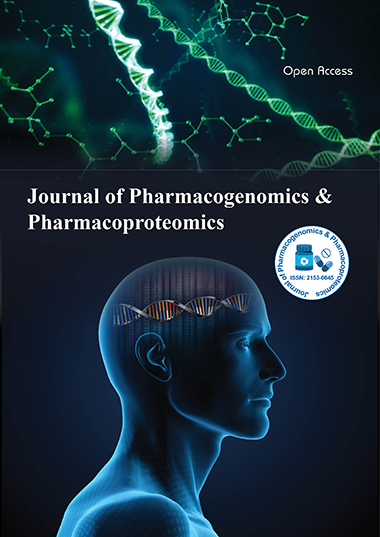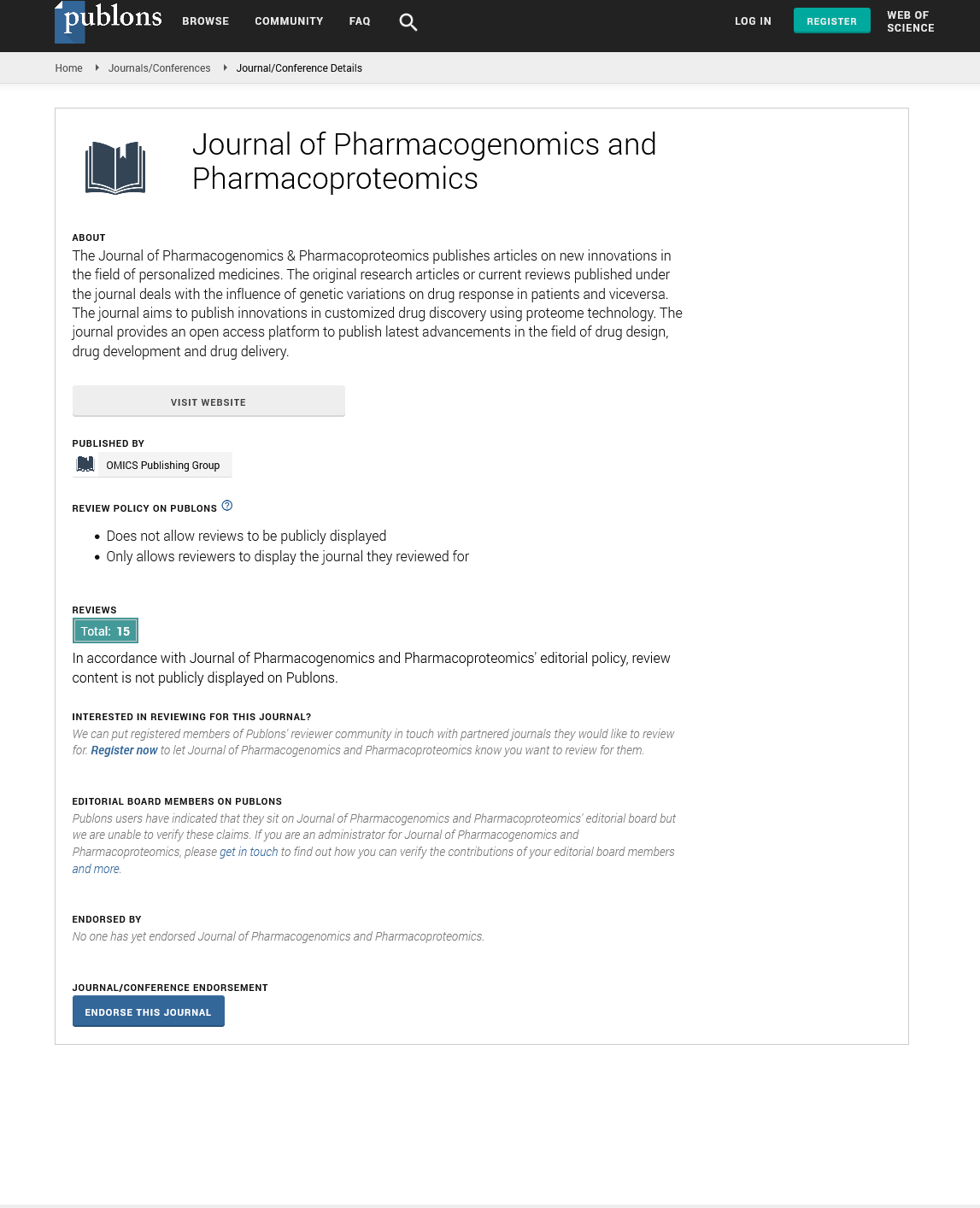Indexed In
- Open J Gate
- Genamics JournalSeek
- Academic Keys
- JournalTOCs
- ResearchBible
- Electronic Journals Library
- RefSeek
- Hamdard University
- EBSCO A-Z
- OCLC- WorldCat
- Proquest Summons
- SWB online catalog
- Virtual Library of Biology (vifabio)
- Publons
- MIAR
- Euro Pub
- Google Scholar
Useful Links
Share This Page
Journal Flyer

Open Access Journals
- Agri and Aquaculture
- Biochemistry
- Bioinformatics & Systems Biology
- Business & Management
- Chemistry
- Clinical Sciences
- Engineering
- Food & Nutrition
- General Science
- Genetics & Molecular Biology
- Immunology & Microbiology
- Medical Sciences
- Neuroscience & Psychology
- Nursing & Health Care
- Pharmaceutical Sciences
Opinion Article - (2024) Volume 15, Issue 4
Advancing Drug Development with Epigenomics and Pharmacodynamics: Implications for Clinical Practice
Haller Jeong*Received: 25-Nov-2024, Manuscript No. JPP-24-27925; Editor assigned: 29-Nov-2024, Pre QC No. JPP-24-27925 (PQ); Reviewed: 16-Dec-2024, QC No. JPP-24-27925; Revised: 24-Dec-2024, Manuscript No. JPP-24-27925 (R); Published: 31-Dec-2024, DOI: 10.35248/2153-0645.24.15.121
Description
Epigenetics and pharmacodynamics are interconnected disciplines playing an essential role in understanding individual variations in drug response, optimizing therapeutic interventions. The integration of these fields provides insights into how epigenetic modifications influence drug efficacy, safety and metabolism, offering potential pathways to personalized medicine. Epigenetics refers to heritable changes in gene expression that do not involve alterations in the underlying DNA sequence. Key mechanisms include DNA methylation, histone modification and non-coding RNA regulation, all of which impact chromatin structure and gene activity. These epigenetic changes are dynamic and responsive to environmental stimuli, making them pivotal in drug response and resistance.
Pharmacodynamics focuses on the biochemical and physiological effects of drugs on the body and the mechanisms of their action. It encompasses the interaction between drugs and their molecular targets, such as receptors, enzymes and ion channels. The variability in drug response can often be traced back to epigenetic factors, which regulate the expression of target proteins and signaling pathways. This interplay highlights the importance of understanding epigenetics in pharmacodynamics to predict drug outcomes more accurately.
DNA methylation is a central epigenetic mechanism influencing pharmacodynamics. The addition of a methyl group to cytosine residues within CpG islands can silence gene expression, affecting drug targets and metabolizing enzymes. For instance, aberrant methylation patterns in genes encoding cytochrome P450 enzymes can alter drug metabolism, leading to variability in drug plasma levels and therapeutic efficacy. Similarly, hyper methylation of tumor suppressor genes can contribute to cancer progression and resistance to chemotherapeutic agents, underscoring the need for methylation biomarkers in oncology.
Histone modifications also play a critical role in drug response by regulating chromatin accessibility. Acetylation, methylation, phosphorylation and ubiquitination of histones can either promote or repress transcription of genes involved in pharmacodynamics. For example, Histone Acetyltransferases (HATs) and Histone Deacetylases (HDACs) regulate genes responsible for cell cycle control, apoptosis and drug resistance. HDAC inhibitors, a class of epigenetic drugs, have shown promise in treating various cancers by reactivating silenced tumor suppressor genes. This demonstrates the potential of targeting histone modifications to enhance drug efficacy.
Non-coding RNAs, including microRNAs (miRNAs) and long non-coding RNAs (lncRNAs), have emerged as key regulators of drug response through their influence on pharmacodynamic pathways. MiRNAs can modulate drug resistance by targeting mRNAs encoding drug transporters and metabolic enzymes. When these miR-21 has been implicated in chemo resistance by down regulating PTEN, a tumor suppressor gene. Understanding the role of non-coding RNAs in pharmacodynamics opens new avenues for developing RNA-based therapeutics and biomarkers.
Epigenetic mechanisms are not only involved in drug efficacy but also in Adverse Drug Reactions (ADRs). Epigenetic modifications can predispose individuals to hypersensitivity or toxicity by altering immune responses or metabolic pathways. For instance, methylation changes in HLA genes have been associated with adverse reactions to certain medications. Incorporating epigenetic profiles into pharmacovigilance strategies can improve drug safety and patient outcomes. The dynamic nature of epigenetic modifications offers opportunities for therapeutic interventions. Epigenetic drugs, such as DNMT inhibitors and HDAC inhibitors, have been developed to reverse aberrant methylation and histone modification patterns. These drugs have shown efficacy in treating cancers and other diseases where epigenetic deregulation is a hallmark. Additionally, combining epigenetic therapies with conventional drugs can overcome resistance and enhance treatment outcomes.
Epigenomics, the genome-wide study of epigenetic modifications, has facilitated the identification of biomarkers for predicting drug response. High-throughput technologies, such as bisulfite sequencing and chromatin immunoprecipitation sequencing, enable comprehensive mapping of methylation and histone modification landscapes. These data provide valuable insights into pharmacodynamic variability and guide the development of precision medicine approaches. Despite the advances, several challenges remain in applying epigenetics to pharmacodynamics. The complexity of epigenetic regulation and its context-dependent nature require comprehensive studies to decipher the underlying mechanisms. Additionally, the reversibility of epigenetic modifications poses questions about the stability and longevity of therapeutic effects. Addressing these challenges requires collaborative efforts across disciplines, including genomics, bioinformatics and clinical pharmacology.
Citation: Jeong H (2024). Advancing Drug Development with Epigenomics and Pharmacodynamics: Implications for Clinical Practice. J Pharmacogenom Pharmacoproteomics. 15:121.
Copyright: © 2024 Jeong H. This is an open-access article distributed under the terms of the Creative Commons Attribution License, which permits unrestricted use, distribution, and reproduction in any medium, provided the original author and source are credited.

